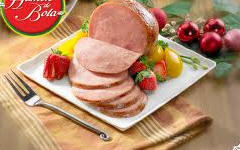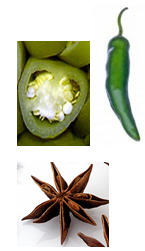What to buy now: Ham
There’s not all the same! Here’s how to buy the tastiest one for your table.
Want to stretch your party budget? Serve ham. It’s easy to make and is a crowd-pleaser. You’ll probably pay more than you did last year due to shortages of the corn that’s fed to hogs. But ham should still be plentiful and be a good buy around the holidays, when supermarkets stock up on it.

Not all hams are alike, so be sure to read the labels. The cheapest type, often labeled “ham and water product”, is made from bits of meat and fat that are pressed together, which means less flavor and texture. It looks like a regular ham but will fall apart when it’s sliced. Ham that’s labeled “water added” is also priced low because it contains less meat and more liquid. But if the label says “natural juices”, the ham will contain more meat and will be juicier.
For easy serving, choose a pre-sliced spiral-cut ham. The meat tends to dry out, so use a glaze and warm it in the oven at a very low temperature.
Black Forest ham, which has a more seasoned outer layer, is usually smaller, in the 2- to 3- pound range. It’s a good choice for small gatherings.
Artisanal hams are the priciest (about $9 a pound) because they come from small producers who raise their animals unconfined, on a vegetarian diet, and without antibiotics. Some are from hogs of a specific breed, such as Duroc or Berkshire. At a supermarket chain such as Whole Foods, those hams will be identified on the label. You can also find them online; Heritage Foods USA and Niman Ranch are tow good sources.
If you’re tempted by a country ham, such as a Smithfield (named for the town, not the producer), know what you’re getting into: You’ll need to scrub off the mold, soak it for up to 24 hours, scrub it again, and then simmer it for hours. The meat will be drier and saltier than heat-and-eat hams and is about $8 a pound. Here’s what else to consider when you shop:
• Pick a good one. Look for a ham with the bone in for the best flavor. Also look for a nice round shape, not a long skinny ham. It will look more appealing on the plate.
• Size it right. You can buy a whole ham or just a half. Either ways, as a main course figure on serving about half a pound of ham per person. Buy less if you’re serving more side dishes.
• Prep like a pro. Most ham just needs to be reheated. Cover it and heat it slowly at a low temperature, ideally 325 °F, until a meat thermometer registers 140 °F. (Heating it at higher temperatures dries out the meat).
• Store it right. You can buy a ham up to 30 days before its sell-by date; store it in the fridge. Leftovers keep for about 48 hours or can be frozen.
Chef’s trick: Spice it up

Fires up the usual sweet glaze for baked ham by adding fresh and dried chilies. In a blender combines diced jalapeno or serrano peppers to taste, a dash of red chili flakes or cayenne, chopped garlic, chopped ginger, star anise, and mango chutney. Puree that mix with a touch of dry sherry or cider vinegar to make a paste to spread on the ham. Cook at 300°F for 1 ½ hours; then raise the temperature to 375 °F for the last 20 minutes to crisp the skin. Sprinkle with chopped cilantro or mint.

